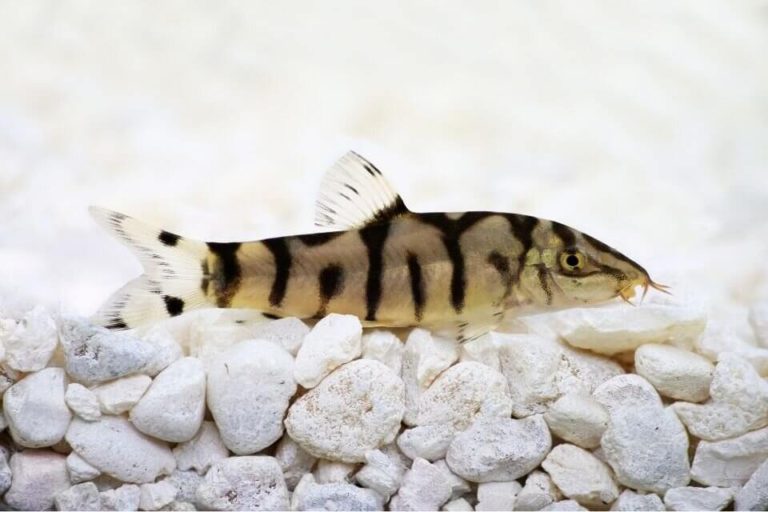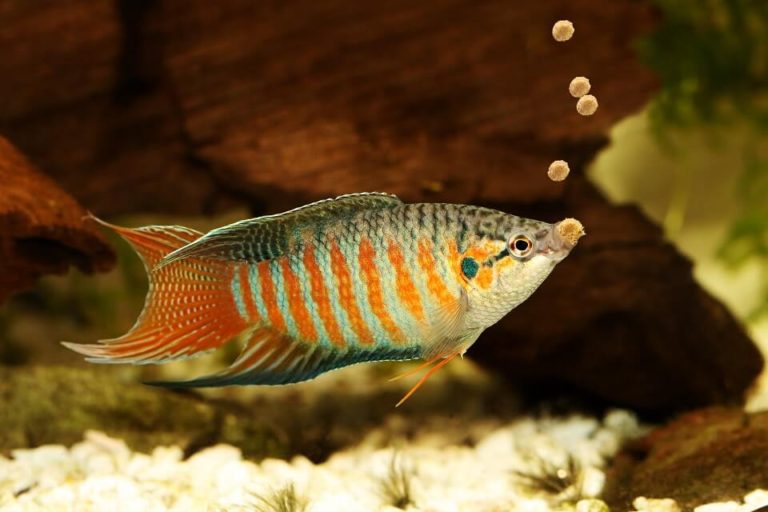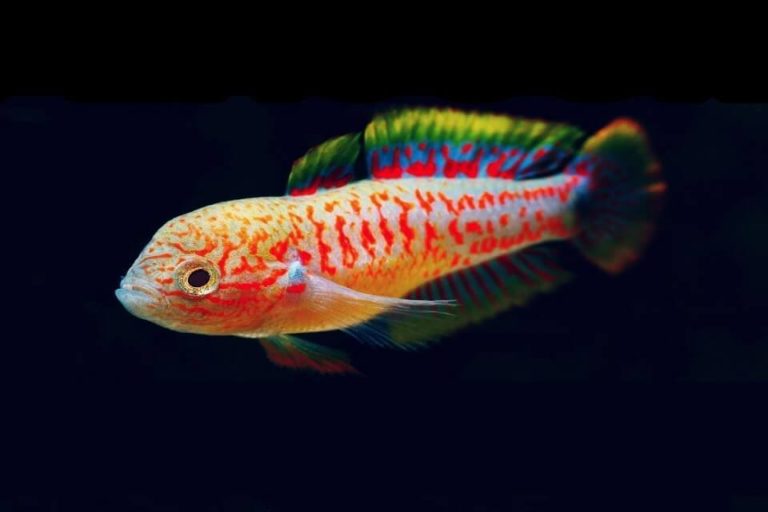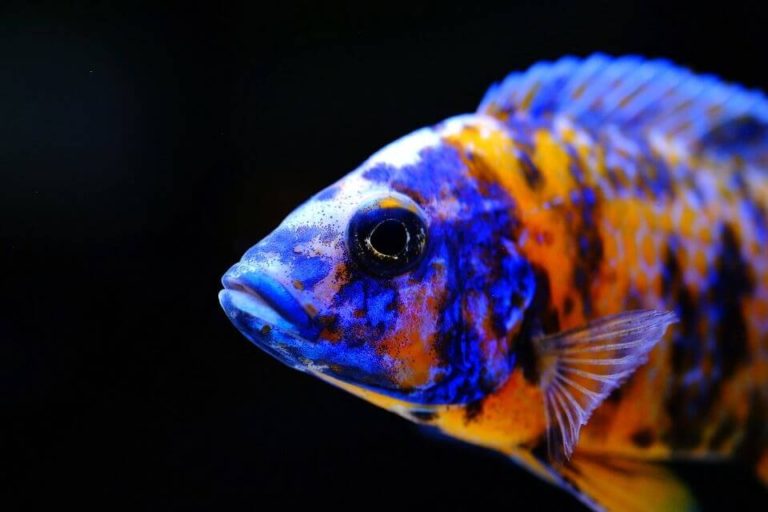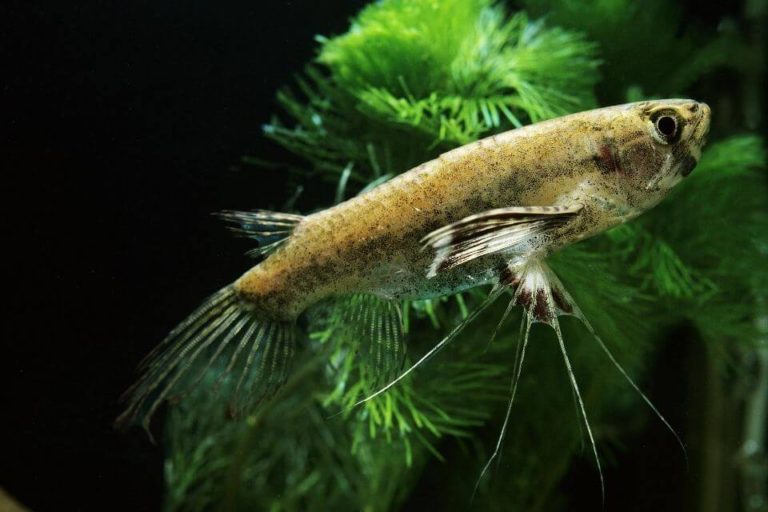Vampire Shrimp Care 101 – Complete Guide to Care, Feeding & Breeding
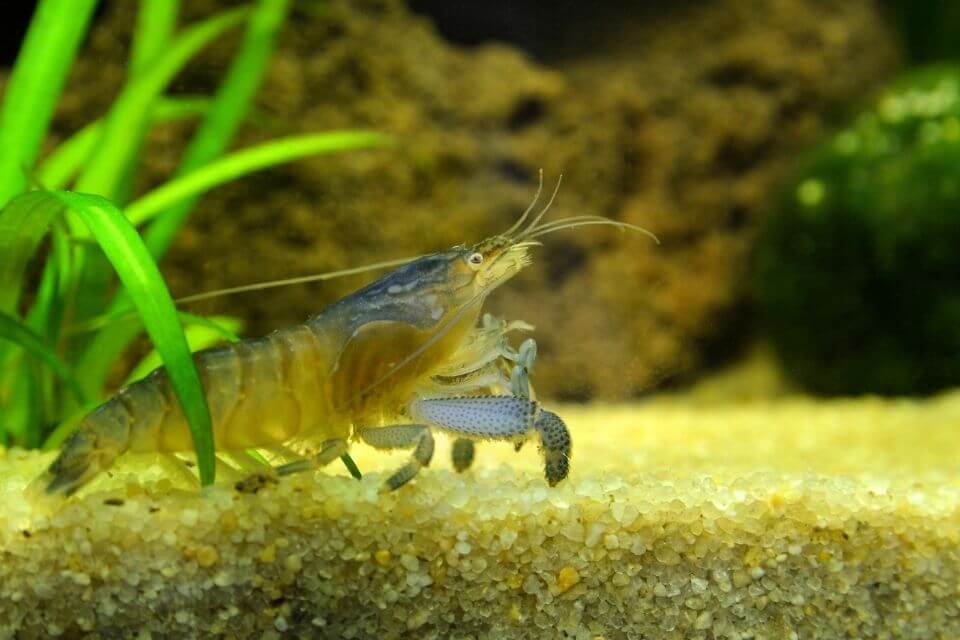
The Vampire Shrimp is arguably the most unique creature in the aquarium hobby that keeping in a freshwater aquarium. They are also one of the least understood creatures, with many misunderstandings and misconceptions about their biology and origination.
This shrimp was first discovered in 1855 by Johann Baptist von Spix and given the name ‘Desmodema polypus’. It would be decades until these shrimp were seen again in the aquarium trade.
However, when they were rediscovered in the 1980s by hobbyists, they quickly became one of the most popular Crustaceans to add to an aquarium tank.
This Vampire Shrimp care article will set out to clear up some of these myths while at the same time building a solid care guide for Vampire Shrimp. Let’s dive in!
Species Overview
The Vampire Shrimp is a unique crustacean found in shallow freshwater bodies of the West African region. It is scientifically known as “Atya gabonensis” and has different common names in the aquarium trade.
The other alternative names are Cameroon Fan Shrimp, African Fan Shrimp, Blue Rhino Shrimp, African Filter Shrimp, African Giant Shrimp, and Gabon Shrimp.
This shrimp is a voracious predator, feeding on small fish and other crustaceans.
They will attack prey much larger than themselves by stunning them with a powerful claw strike before pulling them into their burrow for consumption.
Despite their menacing name, these species are quite peaceful. They spend the majority of their time buried in the sand, surfacing only to hunt.
Vampire Shrimp are popular among aquarists for their interesting behavior and striking appearance. These freshwater crustaceans are easy to care for and make a great addition to any saltwater aquarium.
They can be kept with other fish and invertebrates without issue and will thrive in a temperature range between 72 and 78 degrees Fahrenheit.
Vampire Shrimp Size
The average Vampire Shrimp size is about 3.5 to 5 inches in length depending on the environment they live in. With the optimal captivity conditions, they can get up to 6 inches long.
However, under proper care in an aquarium, they can grow up to 5 inches. They are average size shrimp, but they make up for their size with their big personality.
Also, the shrimp are quite bulkier. They feature a heavy-duty shell for protection
Vampire Shrimp Lifespan
Vampire Shrimp lifespan varies depending on the environment they live in. Some can live for up to 5 years, while others only live for a few months. Atya gabonensis is a hardy species and can tolerate a wide range of water conditions.
However, they should not be kept in water that is too acidic or alkaline. If your tank is stable and healthy and the Blue Rhino Shrimp is well fed, it can live for quite a long time.
However, it is not uncommon for the Shrimp to die shortly after being added into the aquarium. This might be due to the differences in the habitats or stress when being transported.
Vampire Shrimp Appearance & Colors
Their appearance can vary depending on their age and sex. Newborns are typically a light brown or tan, while adults can be a wide variety of colors, including red, green, blue, and black. Some may even have stripes or spots.

The shrimp’s coloring can also be affected by their environment; for example, if they live in a brightly lit area, they may be lighter in color than if they live in a darker area.
It has been said that the colors a Vampire Shrimp displays can be an indication of their mood. For example, a shrimp that is dark green or black may be angry or upset, while one that is brightly colored may be happy.
Behavior & Temperament
These Shrimp species are naturally shy and docile. The shrimp get along well with other tank mates and do not typically bother other inhabitants of the tank.
However, they can be territorial when it comes to their food and will protect their territory if necessary. Vampire Shrimp are generally peaceful creatures and can make a great addition to any tank.
If you are looking for a low-maintenance, peaceful shrimp to add to your tank, the Blue Rhino Shrimp is a great choice. They are docile and can get along with most other fish tank mates.
However, make sure that you have plenty of hiding spots in the tank since these shrimp prefer to spend time out of view.
Vampire Shrimp are very skilled hunters who can see color even in low-light conditions. This makes them perfect for tanks with live plants or dimly lit areas. They will help to keep the tank clean by eating any uneaten food or pesky algae.
So if you are looking for a hardworking, low-maintenance shrimp, the Vampire Shrimp is a great choice! They are typically shy and docile but can defend their territory if necessary.
They are perfect for tanks with live plants or dimly lit areas.
Vampire Shrimp Care
Proper Vampire Shrimp care is typically all that is needed to keep them healthy and happy in the aquarium. They do best in a tank with plenty of live plants and soft substrate, as they like to burrow.
Blue Rhino Shrimp(the alternative name) will eat just about anything, so it’s important to provide a varied diet including both meaty and plant-based foods.
Due to its average size and interesting features, it has become a popular aquarium species but proper care is important for its success.
Vampire Shrimp are quite difficult to care for compared to other shrimp. This is due to their anxious and sensitive nature.
The most important is to keep in mind that your species cannot be exposed to any amount of zinc, copper, or other metals. The shrimp can be introduced through small plant fertilizers that are low in iron.
Make sure to keep a close eye on the water conditions and pH levels, as they must remain stable. Otherwise, your shrimp will likely die.
– Vampire Shrimp Tank Size
The perfect Vampire Shrimp tank size should be no less than 20 gallons. A 20 gallons tank will allow for optimal living conditions and overall health.
Additionally, an average size tank is easy to work with and does not require you to rearrange your entire house just for one more fish.
2 to 3 of Vampire Shrimps can be comfortably housed in a 20 gallons tank. Anything less would be too small and could lead to the shrimp becoming malnourished or even dying.
– Vampire Shrimp Tank Setup
In the wild, their habitats have well-oxygenated water and are generally low in pollutants. To create an environment that is as close to their natural habitat as possible, it is important to keep the following things in mind when setting up your Blue Rhino Shrimp tank:
- Use an air pump and/or powerhead to increase water circulation and oxygen levels.
- Keep the water temperature between 74 to 84 degrees Fahrenheit ( 24 to 29 degrees Celsius).
- Use a substrate of fine sand or gravel to create hiding spaces for the shrimp and find food easily.
- Decorate with some driftwood to provide natural surfaces for algae growth, which Blue Rhino Shrimp love to graze on!
- Keep lighting low or use fluorescent lamps designed for planted tanks to provide a natural look and reduce algae growth.
- Use a water filter to keep the water clean and free of pollutants.
– Water Conditions And Parameters
The Vampire Shrimp are typically filter feeders and so, there should be enough food floating in the water to support them. They are not fussy eaters but they do need a good quality of water and should be kept in an aquarium with stable water conditions.
Keeping your tank well planted will help to maintain water quality and stability, as well as create a natural environment for your Shrimp.
The following water conditions are recommended for them:
- Water temperature: 74 to 84 Degrees Fahrenheit (24 to 29 C)
- Water pH: 6.5 to 8.0
- Ammonia: 00 ppm
- Water hardness: 3 to 10 dKH
– Suitable Aquarium Plants
Live aquarium plants are ideal for giving your shrimp places to explore, eat and play. Some of them are even excellent at helping control algae growth.
Some of the most suitable aquarium plants include:
- Java Moss
- Anubias
- Java Fern
- Amazon Sword
- Riccia Fluitans
- Duckweed
- Water Lettuce
– Common Diseases And Prevention
Vampire Shrimp can experience some health problems with fungal and bacterial infections being the most common. some of the diseases that affect your shrimp include:
Pseudomonas: A type of bacteria that can cause a wide range of diseases in shrimp, including septicemia (blood poisoning), skin lesions, and fin rot. It is often spread through unclean water or food.
Aeromonas: Another type of bacteria that can cause similar problems as Pseudomonas.
Fungal Infections: These can be caused by a variety of fungi, including Aspergillus and Candida. They can cause skin lesions, fin rot, and even death in severe cases. Once bacteria or fungus is contracted, it can be difficult to treat and can often lead to death.
To help prevent your shrimp from contracting these diseases, it is important to maintain good water quality and provide a healthy diet.
Prevention is key for avoiding these diseases, and there are a few things you can do to help keep your shrimp healthy:
- Make sure your water quality is good. This includes keeping the pH at a stable level and having adequate levels of dissolved oxygen in the water.
- Keep your tank clean by regularly doing water changes and cleaning the substrate.
- Provide a balanced diet. This includes having both plant matter and protein in the tank.
- Quarantine any new additions to your tank for several weeks before introducing them to the main tank.
Vampire Shrimp Food And Feeding
Vampire Shrimps get most of their nutrients from feeding on their own, but new Aquarists are not familiar with this concept. The shrimp start feeding once they reach a size of around 1.5cm or more, and can be fed a variety of foods such as brine shrimp, daphnia, cyclops, bloodworms, and small earthworms.
The most common food for them is live food, but they can also be fed frozen food or even pellets. Pellets are not a preferred food but can be used to supplement a diet of live food.
When feeding it is important not to overfeed them, as this can lead to health problems. Overfeeding can also cause the water quality in the tank to decline, so it is important to monitor the shrimp’s eating habits and adjust the feeding schedule accordingly.
Difference Between Male And Female Vampire Shrimp
It is not possible to differentiate between males and females at the young or rather juvenile stage. However, after its molting, the 10th abdominal segment of a male is thick and broad which has three projections. On the other hand, for females, it is thin and narrow.
Sexual maturity in Blue Rhino Shrimp also depends upon its right claw that has a tooth-like projection on the inner surface at its base which is more in males than in females.
Males have also been found to be territorial and they take up a dominant position in their respective habitats while defending it against rivals as well as predators.
Conversely, females have been seen to form cooperative groups while occupying a shared territory. It is also worth noting that female Vampire Shrimp are capable of storing sperm for a protracted period
Vampire Shrimp Tank Mates
Despite their menacing name, these species are docile and peace-loving creatures. You can keep them with any dwarf shrimp or fish that can live in a peaceful community tank. Some ideas for vampire shrimp tank mates include:
Other freshwater Shrimp species, such as Amano Shrimp, Ghost Shrimp, and Cherry Shrimp
Small schooling fish, such as Neon Tetras, Harlequin Rasboras, or White Cloud Minnows.
Vampire Shrimp Breeding
Breeding Vampire shrimp is a challenge as the few species of vampire shrimp are not easy to breed. Vampire shrimp breeding starts with keeping adult specimens separately until mating behavior has been observed.
When ready, care should be taken for the female’s molting cycle and egg carrying on. The first batch of eggs will usually die off but a second spawning may produce some larvae that survive.
Some species of Blue Rhino Shrimp such as the (Atya lanipes) produce larvae that quickly attach themselves to surfaces and become part of the aquarium biofilter.
Origin And Distribution
The Vampire Shrimp originates from West Africa and South America. The Breed has been introduced to the waterways of Florida, where it is believed that they have developed their characteristic feeding behavior.
Their natural habitat is in silty fresh water. They are usually found around the mouth of rivers in undersea caves, tree stumps, or fallen tree branches in water that is up to three feet deep.
Vampire Shrimp are becoming increasingly popular among various communities for their unique feeding behavior. The breed feeds on small fish, shrimp and prawns by sucking their blood.
Naturally shy and reclusive, these species cannot keep you entertained. They originate from freshwater and live in muddy regions. These shrimps adapt easily to aquariums that mimic their natural environment.
How Long Does It Take For A Vampire Shrimp To Molt?
Vampire Shrimp undergo a molting process as they grow. The time it takes for a shrimp to molt varies with the size of the shrimp and environmental conditions. Generally, very small shrimp (
Shrimp that are stressed or in poor environmental conditions may take longer to molt. The molting process is very important for the growth and development of shrimp.
After molting, shrimp can grow larger and stronger, and they also have a new exoskeleton that is better suited for their environment.
How Many Vampire Shrimp Are In A Tank?
15 to 20 gallons is the minimum size for a tank with vampire shrimp. 25 gallons is the recommended size for a tank with vampire shrimp. A group of 2 to 4 can be kept in a 25 gallons tank.
A group of 6 to 8 vampire shrimp can be kept in a 50 gallons tank.
Do Vampire Shrimp Eat Other Shrimp?
Vampire Shrimps are peacefully living by themselves eating dead animals on the ocean floor until they are invaded by more aggressive Grass Shrimps. After many years, Vampire Shrimps have evolved to live together with their ‘enemy’.
The two species of shrimp have formed a symbiotic relationship where they work together against other enemies, protecting one another.
Can Vampire Shrimp Live With Betta Fish?
The answer is yes! Vampire Shrimp and Betta Fish can coexist quite peacefully in the same tank. The Vampire Shrimp may even serve to clean up some of the leftover food that would otherwise end up polluting your tank.
Betta Fish and other community fish will not view the Vampire Shrimp as a source of food. Their hard carapace means that if a Betta or other fish were to take a bite, it would likely only injure its teeth.
As long as you provide some hiding places for the Vampire Shrimp, they should do just fine in a community tank with other fish. Just be sure to give them plenty of room to swim – they can get pretty big!
Can Vampire Shrimp Live With Cherry Shrimp?
Vampire Shrimp and Cherry Shrimp can live together without too many conflicts if their water conditions are correct.
Are Vampire Shrimp Endangered?
The Vampire Shrimp is listed as a vulnerable species by the IUCN. This means that it is at risk of becoming endangered in the future if things don’t change
How Much A Vampire Shrimp Cost?
Vampire Shrimp can be expensive, costing up to $40 per shrimp. They are popular in the aquarium hobby because they are colorful and have interesting behaviors, including feeding on the blood of other fish.
Final Thoughts
Vampire Shrimp can be one of the easiest and most rewarding shrimp to care for, especially if you choose your tank appropriately.
They do need a good source of calcium carbonate (limestone) as well as an ionic/mineral supplement dosed according to the amount of live rock in the tank (or dosing pump).
Proper lighting is another important aspect for these shrimp, with a UVB light being ideal. If you can provide all of these things, your Vampire Shrimp will thrive and bring hours of enjoyment to your home.
We hope you have found this guide helpful.



